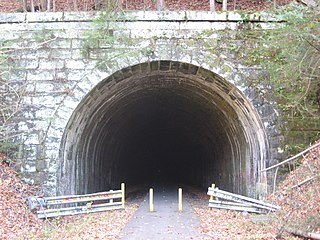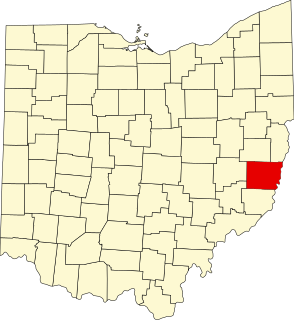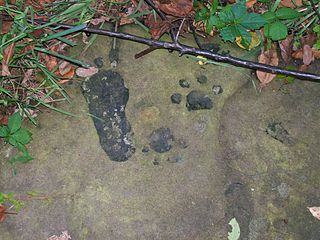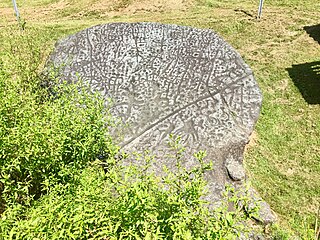
Jefferson Township is a township in Fayette County, Pennsylvania, United States. The population was 2,015 at the 2010 census, down from 2,259 at the 2000 census. It is named for former president Thomas Jefferson, and many of the township's streets are named after other U.S. presidents. Frazier School District serves the area.

Rockland Township is a township in Venango County, Pennsylvania, United States. The population was 1,346 at the 2000 census. The township is quite remote, containing one general store, a Methodist church, and a volunteer fire department. A place of interest is Freedom Falls, where a waterfall and old iron furnace can be found.

A petroglyph is an image created by removing part of a rock surface by incising, picking, carving, or abrading, as a form of rock art. Outside North America, scholars often use terms such as "carving", "engraving", or other descriptions of the technique to refer to such images. Petroglyphs are found worldwide, and are often associated with prehistoric peoples. The word comes from the Greek prefix petro-, from πέτρα petra meaning "stone", and γλύφω glýphō meaning "carve", and was originally coined in French as pétroglyphe.

French Creek is a tributary of the Allegheny River in northwestern Pennsylvania and western New York in the United States.

This is a list of the National Register of Historic Places listings in Fayette County, Pennsylvania.

Washington State Park is a public recreation area covering 2,147 acres (869 ha) in Washington County in the central eastern part of the state of Missouri. It is located on Highway 21 about 14 miles (23 km) northeast of Potosi or 7 miles (11 km) southwest of DeSoto on the eastern edge of the Ozarks. The state park is noted for its Native American rock carvings and for its finely crafted stonework from the 1930s.
Venango Path was a Native American trail between the Forks of the Ohio and Presque Isle, Pennsylvania, United States of America. The trail was named after the Native American village of Venango where French Creek flows into the Allegheny River. The village is now the site of the small city of Franklin, Pennsylvania.

The Red Bird River Petroglyphs, also known as the Red Bird Petroglyphs are a series of petroglyphs, or carvings, on a stone in Clay County, Kentucky. The rock originally was situated along the Red Bird River but was moved to a park in Manchester after it fell onto the roadway below in 1994.

This is a list of the National Register of Historic Places listings in Belmont County, Ohio.

This is a list of the National Register of Historic Places listings in Greene County, Pennsylvania.

This is a list of the National Register of Historic Places listings in Monongalia County, West Virginia.

The Barnesville Petroglyph petroglyph site in the eastern part of the U.S. state of Ohio. Located approximately 3 miles (4.8 km) southwest of the village of Barnesville in Belmont County, the petroglyphs have been known both by archaeologists and the general public since the 1850s or earlier. Although the site was significantly damaged during the twentieth century, it is still a significant archaeological site, and has been named a historic site.

The Sommerheim Park Archaeological District includes a group of six archaeological sites west of Erie, Pennsylvania in the United States. The sites are in Sommerheim Park, one of the few undeveloped areas of the Lake Erie shoreline, in Millcreek Township. This district has been listed on the National Register of Historic Places. This is one of the leading archaeological sites in the Erie area and along the southern shoreline of Lake Erie, due to the amount of artifacts and the lack of disturbance on the site.

The Francis Farm Petroglyphs are a group of petroglyphs in the southwestern part of the U.S. state of Pennsylvania. Located on a boulder in Jefferson Township in the northwestern portion of Fayette County, it has been known to archaeologists since at least the middle of the nineteenth century. Despite damage in the 1930s, it remains an important archaeological site, and accordingly, it has been designated a historic site.

James L. Swauger was an American archaeologist known for his work on the petroglyphs of the Ohio River valley of the United States. A native of West Newton in Westmoreland County, Pennsylvania, he moved to the Pittsburgh suburb of Edgewood in his youth; there he lived for most of the rest of his life.

The Sugar Grove Petroglyphs are a group of petroglyphs in the southwestern part of the U.S. state of Pennsylvania. Located on an outcrop of sandstone in Monongahela Township near the eastern edge of Greene County, the petroglyphs have been known since at least the 1930s. Due to their value as an archaeological site, the petroglyphs have been named a historic site.

Judaculla Rock is the name of an archeological site that features a curvilinear-shaped outcrop of soapstone known for its ancient carvings and petroglyphs. It is located on a 0.85-acre rectangular-shaped property, now owned by Jackson County. It is approximately 60 meters east of Caney Fork Creek, a major branch of the northwestward-trending Tuckasegee River, in the mountains of Western North Carolina.

Big and Little Indian Rock Petroglyphs is a prehistoric archaeological site located at Conestoga Township in Lancaster County, Pennsylvania. It consists of two large rocks located in the Susquehanna River. Big Indian Rock is 60 feet by 40 feet, and has carvings on all sides. The Little Indian Rock measures 38 feet by 32 feet and has carvings on the north side. The petroglyphs were first studied in 1934, and are believed to be by an Algonkian tribe.



















